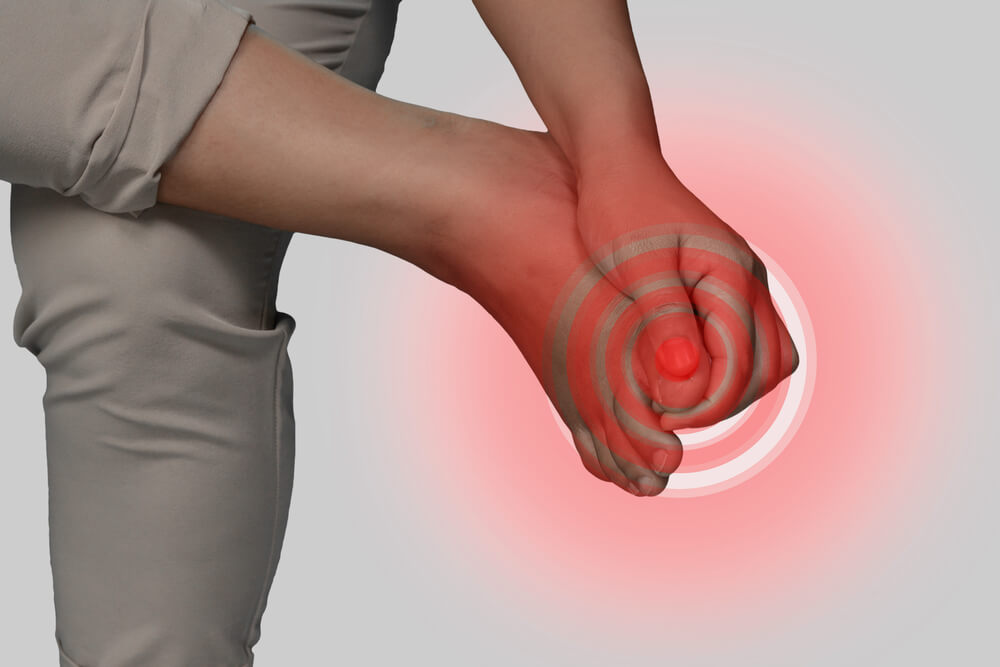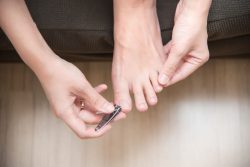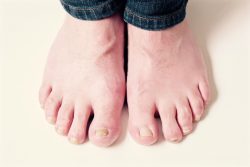
Ingrown Toenails
An ingrown toenail (onychocryptosis) is a painful yet common condition where the side of a toenail grows into and penetrates the soft tissue of the toe. An ingrown toenail causes pain, redness, swelling and can even cause an infection. Ingrown nails can occur in the fingernails and toenails but most commonly affects the big toe.
CAUSES
A few of the most common causes of ingrown toenails include:
- Poor Fitting Shoes: Wearing tight shoes that cause the toes to crowd and bunch up can cause ingrown toenails. Ill-fitting shoes that are too narrow or short are also a typical cause of ingrown toenails especially with growing children during developmental stages of growth and also with active young adults.
- Poor Nail Care: When toenails are incorrectly cut too short or rounded off at the tip it can cause ingrown toenails.
- Broken Toenail: A toenail that breaks below the normal length can cause an ingrown toenail as the nail begins to grow back.
- Injured Toe/Toenail: Trauma to the toe or toenail due to a stubbed toe or a blunt force injury like dropping a heavy weight on the toe, may cause damage to the nail plate and result in an ingrown toenail.
- Heredity: Family genes that engender unusually curved, pointy, or jagged toenails may be prone to ingrown toenails. Abnormally shaped nail beds may also contribute to the condition.
- Disease: Diseases that cause toenail deformities can cause ingrown toenails even without the common causes listed above.
Prevention
There are several things that can be done to prevent ingrown toenails:

- Wear Proper Fitting Shoes: Wearing comfortable fitting, roomy shoes is a great ingrown toenail prevention. Consider visiting a shoe store that has a foot measuring devise to find your current shoe size, specifically measuring the width of the foot. Feet can continue to grow after height growth has ceased.
- Proper Nail Care: Cutting toenails straight across the nail and no shorter than the flesh around it is a recommended prevention. Sharp square corners that can cause snagging when putting on socks can be slightly filed rounding the edge is acceptable and recommended.
- Special Care: In cases of injury, heredity or disease, paying special attention to the toenails frequently and taking the time to care for and treating susceptible toenails is a preventive necessity.
Home Treatment
Dr. Ward encourages his patients to try home treatments in mild to moderate cases of ingrown toenails. Some simple home treatments and remedy’s include:
- Give your Toe a Break: Wear sandals and avoid tight fitting shoes, high heels, boots or any other footwear that may apply pressure to the toe.
- Soaking the Toe: Treat the affected toe with warm water and with dissolved Epsom salt. Soak the toe three to four times a day for three days.
- Lift the Nail: After soaking the toe, gently lift the corner of the nail that is digging into the skin and place a small piece of cotton between the nail and skin. This may be painful at first but can be effective to create a growing pattern of the nail different than into the skin. It may take two weeks or more for the nail to change its pattern.
- Dental Floss Threading: After soaking the toe, carefully thread a piece of dental floss under the nail transversely under both sides. Glue or tape the floss to the edges of the nail to keep the nail and skin separated and the dental floss in place.
WHEN TO CALL DR. WARD
Whether or not the suggested home remedies listed above have been attempted, an appointment with Dr. Ward should be made if:
- There is severe pain in the toe or if pus and redness seem to be spreading.
- Lifestyle, like an athlete’s ability to run, is hampered because of pain.
- A patient has diabetes or another condition causing poor blood circulation to the feet and infection is evident.
MINOR SURGICAL TREATMENTS
After an examination, Dr. Ward may choose one of the following treatments:

- Lifting the Nail: Similar to the home remedies above, Dr. Ward may attempt to lift the nail and place cotton, dental floss or a splint under the nail to separate the nail from the skin.
- Partial Removal: Dr. Ward may suggest removing a partial portion of the toenail. After injecting the toe with an anesthetic, Dr. Ward trims or removes the ingrown portion of the toenail.
- Removing the Nail and Tissue: In cases where the problem persists or is amply severe, Dr. Ward may suggest removing a portion of the toenail along with the underlying tissue called the nail bed. This procedure may prevent that part of your nail from growing back. After injecting the toe with an anesthetic, Dr. Ward may use a chemical, laser or other method to perform the procedure.
Ingrown toenails are common and can be sensitive and painful. If you are constantly dealing with an ingrown toenail, try the home remedies above or over-the-counter products if you desire. If these solutions do not work, contact Dr. Ward for an evaluation and treatment options.
